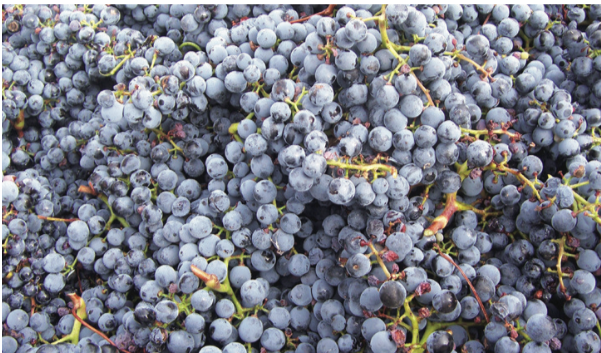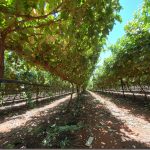By Frank van de Loo Winemaker, Mount Majura Vineyard, Canberra District
First published in the January/February 2016 issue of the Wine & Viticulture Journal

Graciano has occupied an acre of Mount Majura Vineyard since 2002, and has not only earned its place, but is earmarked for expansion. We love it for its distinctive spicy fragrance and juicy medium-bodied style. When I last wrote about the variety1, I explained that the impetus for planting was the apparent suitability for the Canberra District climate, being similar to its home in Rioja, Spain, and the attraction of its reputation for being a distinctive and high-quality variety in Rioja.
As a native variety of Rioja, Graciano is mostly and traditionally used in Tempranillo-dominant blends, but some varietal wines have appeared more recently. A champion of the region’s indigenous varieties, Juan Carlos Sancha made the first single-varietal Graciano for Viña Ijalba in 1995 (“It would have been the first in the world,” he says ruefully, “but for Brown Brothers in Australia”)2. The varietal Graciano from Bodegas Beronia, in Rioja, is available in Australia. Graciano was introduced to Australia around 1908 and has been grown at Milawa by Brown Brothers since 1920, though only made as a varietal since 1965.
Graciano is now more widely grown in Australia3, but strangely enough is concentrated in maritime regions such as McLaren Vale and Margaret River, as well as Barossa and Riverland.
Back in 20101, following seven hot and dry years, an important attraction of Graciano was that it stood up well to these conditions. Five years on, we’ve had some cool and/or wet years, but the climate is only getting warmer, and late ripening varieties like Graciano seem even better.
Graciano is considered a low-yielding variety in Spain, but our material (SAVI01 clone) tends to overcrop considerably. The difference appears to be explained by the removal of leaf roll virus1. Two new clones (RJ117, RJ58) were recently introduced to Australia from Spain by Adelaide Hills Vine Improvement, and they are supposed to be virus free and moderate yielding, so it will be interesting to see how they perform in our conditions.
The bunches are very large, though not too tight, and the berries are small. The skins are quite thin, and it will suffer from both sunburn and botrytis if conditions get difficult, but otherwise we’ve found it easy-going, and usefully resistant to powdery mildew compared with its neighbouring Tempranillo.
Budburst and ripening are both late, similar to Cabernet Sauvignon, but obviously the ripening will depend on control of crop level. We apply anti-transpirant pre-flowering to try to reduce set, but still need to follow up with heavy bunch thinning.
Our vines are on a Smart-Dyson trellis, but we now generally don’t use the Smart-Dyson wire, as the canopy is not too dense and too much fruit exposure risks sunburn. In our case the south-side foliage wires are lifted and the north side left to sprawl. We prune to one-bud spurs but otherwise manage Graciano as for most of the vineyard. A permanent sward is cut with an undervine slasher rather than using herbicide in order to maintain and develop soil organic matter. Grass is kept short through October to minimise frost risk, but then we slash alternate rows to extend pollen production, feeding beneficials.
The canopy is larger and healthier and fruit is less prone to sunburn if our boron deficiency is well managed. Graciano is notably sensitive to B deficiency, so soil and petiole tests on new sites are highly recommended.

Despite the relatively thin skins, Graciano berries have a beautiful blueish colour, and this translates to excellent colour in the wine. Even when the colour is not deep, as in wine made from less-ripe fruit, the hue is excellent and often remarked on.
Our winemaking for Graciano is fairly standard. Fruit is destemmed and pumped to open fermenters where it has some pre-ferment maceration waiting for wild ferments to start. Ferments are hand-plunged and the temperature is capped at 30°C. Wine is pressed after a few days post-ferment maceration, settled overnight and racked to old oak, where it completes MLF and matures typically for seven months.
The name Graciano is supposed to relate to its acidity, bringing ‘grace’ to the Rioja blend, and indeed we always find it to have delicious fresh acid. The TA is generally not high (6.5-8.5g/L at harvest), but we never add acid to this variety and pH is always low, typically being 3.2 at harvest and below 3.5 post- MLF. On the other hand, we need to add acid to Tempranillo, and just blending Graciano with Tempranillo wouldn’t do it – the Graciano would be in such a high proportion as to dominate the wine.
Graciano doesn’t need to be super-ripe to make good wine. In most years we ripen only to about 12 Baume and make a wine that is spicy, fresh, vibrant and bright in a style that has become very well accepted by consumers and sommeliers. The aromatics are very distinctive to the variety: pepper, szechuan pepper, red berries, red liquorice, while the tannins are soft and fine. In 2013 we picked at 13.9 Baume at which the wine was plusher with deeper fruit and more ‘impressive’ while not necessarily being better. In warmer climates where it is easier to achieve high ripeness, winemakers might carefully assess whether earlier picking doesn’t make the more vibrant, distinctive and interesting wine, though many impressive riper wines have been made.
The varietal wine is popular at cellar door and particularly with restaurants, making an interesting point of difference, and a good wine for food. We’ve often had the experience at public tasting events of word getting around and people coming up to say that their friends told them to come and try the Graciano, illustrating the thirst that exists for something medium-bodied and different.
We also use Graciano in our very successful TSG blend with Tempranillo and Shiraz, and it is likewise used by many other wineries in blends, often with Tempranillo. One of the most successful, bagging several trophies, has been Rosemount’s Graciano Mataro Grenache blend. In our TSG, Graciano often contributes more of the spice and pepper than Shiraz does, and it seems that in warmer regions that do not easily make spicy Shiraz, a little Graciano could be a useful addition.
Graciano in Rioja has a reputation for bringing longevity to Tempranillo blends, and we are certainly pleased with the development of our earliest vintages, the 2006 for instance still has some years ahead of it. We’re looking forward to growing more Graciano at Mount Majura Vineyard, and seeing more of it grown around the country.
REFERENCES
1 van de Loo, Frank (2010) Grace under pressure: Graciano offers quality in warm and dry conditions. Wine Industry Journal 25(1):11-13.
2 Wislocki, Amy (2009) Rioja: the rise of indigenous grape varieties. Decanter. Published 9 October 2009. Accessed 6 January 2016.
3 Higgs, Darby: http://www.vinodiversity.com/ graciano.html
Graciano

By Peter Dry, Emeritus Fellow, The Australian Wine Research Institute
Background
Graciano (grass-ee-AH-no) is an old variety of likely Spanish origin. Globally there were 3102 ha in 2010 (up 62% from 2000), 74% in Spain, particularly in the northern regions of Rioja and Navarra. It is very widespread around the Mediterranean with many synonyms: Bovale, Bovale Saro, Bovaleddau, Cagliunari, Caldareddhu and Calda Recio (Sardinia, Italy), Courouillade and Morastell (Languedoc, France), Minustellu (Corsica, France), Monastrell Menudo (Spain), Tintilla de Rota (Jerez, Spain) and Tinta Miuda (Alentejo, Portugal). It is only in recent times that some of above synonyms have been shown to be the one and same variety as a result of DNA analysis. Also some other varieties have been mistaken for Graciano—including Paraletta (which itself has been mistakenly called Carignan in Australia). Therefore, it is perhaps not surprising that Graciano is related to Carignan (syn. Mazuelo). Graciano was more widely planted in Spain before the advent of phylloxera but it has since declined, probably a result of its low yield. A more recent appreciation of its contribution to Rioja blends has led to a modest expansion—but it still only makes up 2% of the total area of Rioja. Also, it was more widely planted in the Languedoc (France) in the past. After Spain, the largest area of Graciano is found in southern Portugal. In Australia, Graciano has been grown at Milawa (Vic.) by Brown Brothers since the 1920s. Newer clones were introduced from Spain and California in the 1960s. The total area in Australia has always been very small with little prospect of significant expansion. Nevertheless, there are currently at least 47 wine producers in Australia (in more than 18 regions), mainly McLaren Vale, Barossa Valley, Margaret River and the Riverland of SA. In 2016 there were 14 ha in SA.
Viticulture
Budburst and maturity are late. Vigour is high with erect growth habit. Bunches are medium to large and compact with small tough-skinned berries. Yield is usually low (half that of Tempranillo) and variable. It is normally spur pruned. Graciano is tolerant of powdery mildew and is also said to be drought tolerant.
Wine
Graciano wines are deeply coloured and rich in tannins. Must acidity is high and this is one reason why it is found in blends with lower acidity varieties such as Tempranillo. Wines have light to medium body unless picked very ripe. Wine descriptors include minty, spicy, dried herbs and dark fruits. In Europe, Graciano is usually blended with other varieties: for example, it adds freshness and aromatics to the Rioja blend with Tempranillo and Carignan. In Sardinia and Corsica, it is usually blended with Grenache or Carignan. In Australia, Graciano is used as a single variety or in blends with Tempranillo.




















